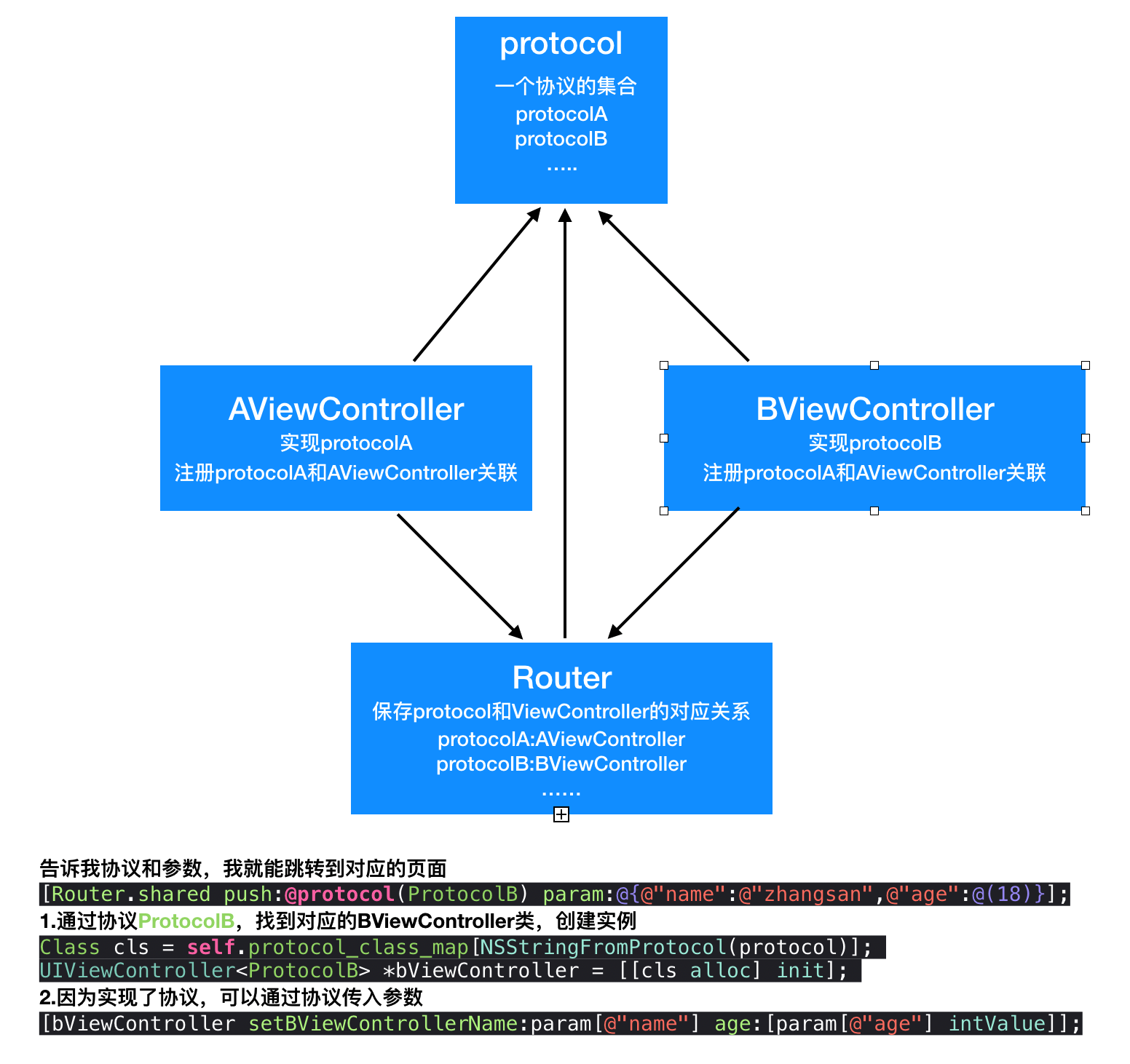定义一个protocol,叫protocolB,让BViewController实现。
protocolB里面可以定义BViewController创建时需要的参数,例如这里的name和age。
@protocol ProtocolB <NSObject>
- (void)setBViewControllerName:(NSString *)name age:(int)age;
@end
BViewController实现protocolB
#import "ProtocolB.h"
- (void)setBViewControllerName:(NSString *)name age:(int)age
{
self.nameText = name;
self.ageText = [NSString stringWithFormat:@"%d",age];
}
在router里#import "ProtocolB.h",定义register方法,将protocol和class对应起来,保存到字典protocol_class_map
@property(nonatomic, strong) NSMutableDictionary *protocol_class_map;
- (void)registerProtocol:(Protocol *)protocol forClass:(Class)cls;
在BViewController里注册
// 如果在其他地方注册,必然要引入BViewController,造成耦合
[[Router shared] registerProtocol:@protocol(ProtocolB) forClass:BViewController.class];
在register方法里将BViewController和ProtocolB关联,
在AViewController里
#import "Router.h"
#import "ProtocolB.h"
[Router.shared push:@protocol(ProtocolB) param:@{@"name":@"zhangsan",@"age":@(18)}];
push方法实现
- (void)push:(Protocol *)protocol param:(NSDictionary *)param
{
Class cls = self.protocol_class_map[NSStringFromProtocol(protocol)];
UIViewController<ProtocolB> *bViewController = [[cls alloc] init];
[bViewController setBViewControllerName:param[@"name"] age:[param[@"age"] intValue]];
[[self topViewController] pushViewController:bViewController animated:YES];
}
这段代码干的事:
1.通过协议ProtocolB,找到对应的BViewController类,创建实例
Class cls = self.protocol_class_map[NSStringFromProtocol(protocol)];
UIViewController<ProtocolB> *bViewController = [[cls alloc] init];
2.因为实现了协议,可以通过协议传入参数
[bViewController setBViewControllerName:param[@"name"] age:[param[@"age"] intValue]];
用一张图总结:

再总结:
我觉得最理想的router是,只要AViewController引入router就可以跳转到BViewController。
这里的操作是,ViewController要有相应的protocol,然后ViewController要实现这个protocol,然后ViewController要注册protocol和ViewController的关联,因为要router来注册,所以还要导入router。
这里的router还要导入protocol。
router通过导入每个ViewController对应的Protocol来避免导入具体的ViewController,本质上,我觉得没有区别。
的确比较麻烦,不是很好的方案。
作者:桔子听
链接:https://www.jianshu.com/p/bbcf06e80f14
来源:简书
著作权归作者所有。商业转载请联系作者获得授权,非商业转载请注明出处。






















 638
638











 被折叠的 条评论
为什么被折叠?
被折叠的 条评论
为什么被折叠?








